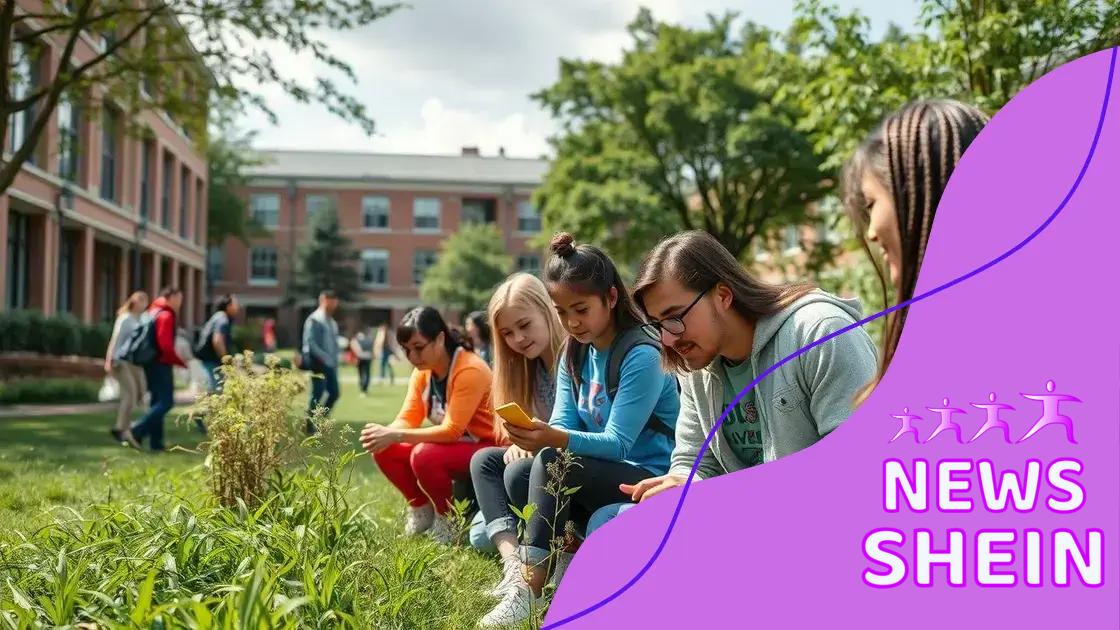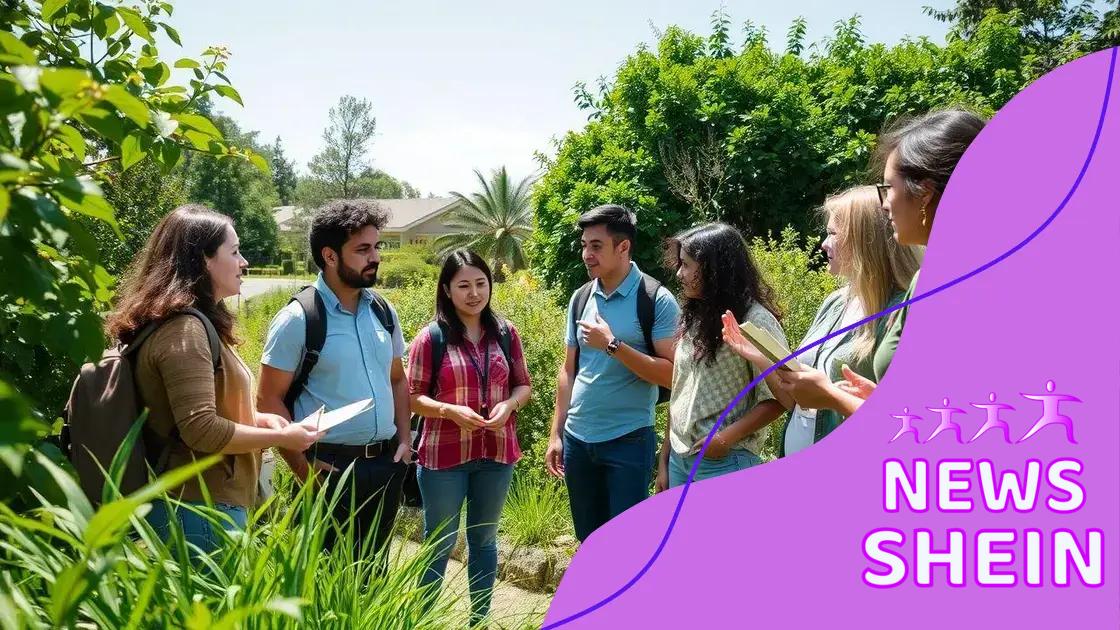How universities are integrating climate change education

Universities are integrating climate change education through innovative teaching methods, partnerships with environmental organizations, and real-world applications, empowering students to address environmental challenges effectively.
How universities are integrating climate change education is reshaping academic landscapes. As the urgency of climate action rises, universities are stepping up to prepare students for a sustainable future. But how are they doing this? Let’s dive in.
The role of universities in climate action
Universities play a crucial role in climate action, not just as educational institutions but as leaders in activism and research. By taking initiatives to reduce their carbon footprint and promote sustainability, they lead by example for students and the community.
Commitment to Sustainability
Many universities now have sustainability offices that focus on implementing green policies and practices. These offices often coordinate efforts that bring together students, staff, and faculty.
- Developing sustainable campus operations.
- Implementing energy-efficient systems.
- Encouraging recycling and waste reduction.
- Offering training programs on sustainability.
Research initiatives at universities also significantly contribute to climate action. Researchers work on innovative solutions, from renewable energy technologies to sustainable agriculture practices. Students often collaborate in these projects, gaining hands-on experience.
Engagement with Local Communities
Universities engage with local communities by running programs that address climate change issues specific to their regions. Collaborating with non-profit organizations and local governments, they help develop actionable strategies.
- Hosting community workshops on environmental conservation.
- Participating in tree-planting initiatives.
- Promoting climate education in local schools.
The collaboration between universities and communities fosters a greater understanding of climate issues, creating a ripple effect that motivates collective action.
By integrating climate change into their curricula, universities prepare students to be the leaders of tomorrow. This education includes not only scientific understanding but also the social and economic implications of climate change.
Future Challenges and Opportunities
Looking ahead, universities face challenges in keeping up with climate science and technology advancements. However, these challenges also present opportunities for growth. Adapting and evolving their programs will allow them to stay relevant and impactful.
Involving students in decision-making about sustainability policies empowers them and fosters a sense of responsibility. This involvement can lead universities to innovative practices while cultivating a generation that prioritizes climate action.
Innovative teaching methods for climate education
Innovative teaching methods for climate education are reshaping how students understand and engage with environmental issues. These methods go beyond traditional lectures, integrating interactive and experiential learning.
Hands-on Learning
One effective approach is hands-on learning, where students participate in real-life projects. By working on sustainability initiatives, they gain practical experience and understand the impact of climate change on their communities.
- Conducting campus-wide recycling drives.
- Building community gardens.
- Participating in local conservation projects.
This style of learning not only informs students but also empowers them to take action. When students see the tangible effects of their work, it enhances their commitment to environmental issues.
Collaborative Learning
Collaborative learning encourages students to work together on climate-related challenges. Group projects foster teamwork and diverse perspectives. By tackling issues as a team, students develop important skills for their future careers.
- Creating presentations on renewable energy sources.
- Developing proposals for sustainable campus practices.
- Engaging with local experts for insights and mentorship.
Such collaboration not only enhances understanding but also builds a community of motivated individuals eager to address climate challenges together.
Another innovative method is the use of technology in the classroom. Online simulations and interactive platforms allow students to explore climate models and visualize data. They can experiment with different scenarios to understand the potential impacts of climate-related policies.
Project-Based Learning
Project-based learning focuses on long-term projects that tackle complex questions related to climate change. Students engage in research, problem solving, and critical thinking to explore and devise solutions.
They might investigate local water quality issues or analyze the carbon footprint of their campus. This approach deepens their knowledge and allows them to apply what they’ve learned in practical ways.
By integrating various innovative teaching methods, universities can create a dynamic learning environment. This environment not only builds knowledge but also fosters a passion for environmental stewardship.
Partnerships between universities and environmental organizations

Partnerships between universities and environmental organizations play a vital role in addressing climate change. These collaborations create a bridge between academic research and practical action.
Collaborative Research Projects
One of the main benefits of these partnerships is the ability to engage in collaborative research projects. Universities often provide cutting-edge research facilities and knowledgeable staff, while environmental organizations offer real-world data and community access.
- Developing sustainable technologies.
- Conducting ecological impact assessments.
- Creating conservation strategies based on scientific research.
This synergy enhances the effectiveness of climate solutions and allows students to apply their learning to real-world problems, deepening their understanding of environmental issues.
Internship and Volunteer Opportunities
Partnerships also create valuable internship and volunteer opportunities for students. Engaging with environmental organizations allows students to gain hands-on experience while making meaningful contributions to their communities.
- Participating in wildlife conservation efforts.
- Helping implement community recycling programs.
- Assisting in urban restoration projects.
These experiences not only build professional skills but also instill a sense of responsibility toward the environment. Students learn how to communicate effectively and work in diverse teams.
Furthermore, these partnerships often result in joint workshops and public events. Universities can host forums or lectures featuring experts from environmental organizations, enriching the educational experience for students and the community.
Enhancing Policy Advocacy
By working together, universities and environmental organizations can advocate for stronger environmental policies. They can conduct studies that influence local or national policies, using academic research to back up proposals for sustainable practices.
Sharing findings with policymakers and the public encourages collaboration on climate action initiatives. This combined effort amplifies the impact of their research and raises awareness about the importance of sustainability.
Ultimately, strong partnerships between universities and environmental organizations empower both entities to drive meaningful change. They create a network of support that enhances education, research, and community engagement in the fight against climate change.
Real-world applications of climate studies
Real-world applications of climate studies are crucial for addressing environmental challenges. These studies provide valuable insights that can be applied to solve pressing issues related to climate change.
Climate Modeling
Climate modeling is one significant application of climate studies. Through advanced simulations, researchers can predict future climate conditions and assess the potential impacts of various scenarios. This knowledge helps governments and organizations develop strategies for adaptation and mitigation.
- Understanding regional climate patterns.
- Forecasting extreme weather events.
- Evaluating the effects of policy changes on emissions.
By using data-driven models, decision-makers can make informed choices that prioritize sustainability and resilience in the face of climate challenges.
Sustainable Agriculture
Another important application is in sustainable agriculture practices. Climate studies guide farmers on how to adapt to changing weather patterns. By understanding the local climate, farmers can implement methods that enhance crop resilience and resource efficiency.
- Using drought-resistant crop varieties.
- Implementing water conservation techniques.
- Practicing crop rotation to improve soil health.
These strategies not only ensure food security but also promote environmental stewardship, allowing agricultural practices to coexist with ecological preservation.
Moreover, climate studies often inform urban planning. Cities can address climate impacts by incorporating green spaces, improving public transportation, and enhancing building designs for energy efficiency. This planning helps create environmentally friendly and sustainable urban environments.
Policy Development
Real-world applications also extend to policy development. Policymakers rely on climate research to craft regulations that reduce carbon emissions and address other environmental concerns. Effective policies often stem from well-informed analyses of climate data and trends.
Collaborations between researchers and policymakers enable the implementation of innovative solutions, such as renewable energy incentives and waste reduction programs. These initiatives can lead to more sustainable communities, fostering a culture of environmental responsibility.
In conclusion, the real-world applications of climate studies empower various sectors to respond effectively to climate change. By translating findings into practical solutions, we can drive change and promote a sustainable future.
Future trends in climate change education
Future trends in climate change education focus on integrating new technologies and approaches to better prepare students for a changing world. Educational institutions are increasingly recognizing the need to incorporate sustainability into all aspects of learning.
Blended Learning Environments
One trend is the shift towards blended learning environments. This approach combines traditional classroom methods with online learning. Students can engage with interactive digital resources alongside face-to-face instruction.
- Accessing online simulations to understand climate models.
- Participating in virtual field trips to study ecosystems.
- Using interactive platforms for collaborative projects.
This blend allows for greater flexibility and accessibility, enabling students to learn at their own pace while still receiving guidance from educators.
Interdisciplinary Approaches
Interdisciplinary approaches are becoming more common in climate change education. Subjects like science, social studies, economics, and art are integrated to give students a holistic understanding of climate issues.
This method helps students see the connections between their learning and real-world applications. For example, they might analyze the economic impact of climate change while exploring scientific data and creating art projects depicting environmental issues.
Empowerment through Activism
Another emerging trend is empowering students through climate activism. Schools increasingly encourage students to participate in local environmental initiatives and advocacy. This involvement fosters a sense of responsibility and leadership among young people.
- Joining local clean-up drives.
- Campaigning for sustainability practices.
- Participating in climate action groups.
By engaging in activism, students become passionate advocates for change. They not only learn about issues but also take action to create solutions.
Finally, technology plays a crucial role in shaping the future of climate change education. Advances in data visualization tools and communication platforms enhance learning experiences. Students can engage with real-time climate data and collaborate with peers around the globe.
As these trends evolve, the goal remains the same: to equip students with the knowledge and skills they need to tackle climate challenges head-on and contribute to sustainable practices in their communities.
In conclusion, understanding climate change education is essential for shaping a sustainable future. By using innovative teaching methods and fostering real-world applications, universities prepare students to tackle pressing environmental issues. Partnerships with environmental organizations and an emphasis on empowerment through activism further enhance learning experiences. As we embrace new trends, such as blended learning and interdisciplinary approaches, the focus remains on equipping the next generation with the tools they need to make a positive impact on our planet. Together, we can create a more resilient and aware society ready to confront climate challenges.
FAQ – Frequently Asked Questions about Climate Change Education
What are innovative teaching methods in climate change education?
Innovative teaching methods include hands-on learning, blended environments, and interdisciplinary approaches that engage students in real-world applications.
How do partnerships enhance climate change education?
Partnerships with environmental organizations provide students with practical experience, research opportunities, and community engagement that enrich their learning.
What role does technology play in climate change education?
Technology enables interactive learning experiences, such as online simulations and real-time data analysis, which help students grasp complex climate concepts.
Why is student empowerment through activism important?
Empowering students through activism fosters responsibility and motivates them to take action on environmental issues, preparing them to be future leaders.






